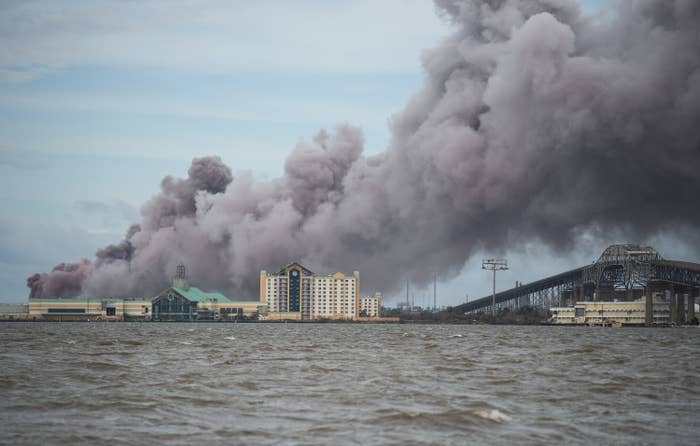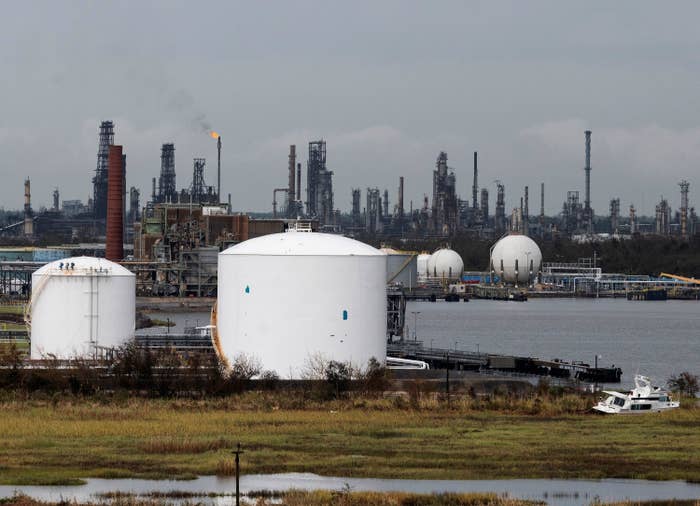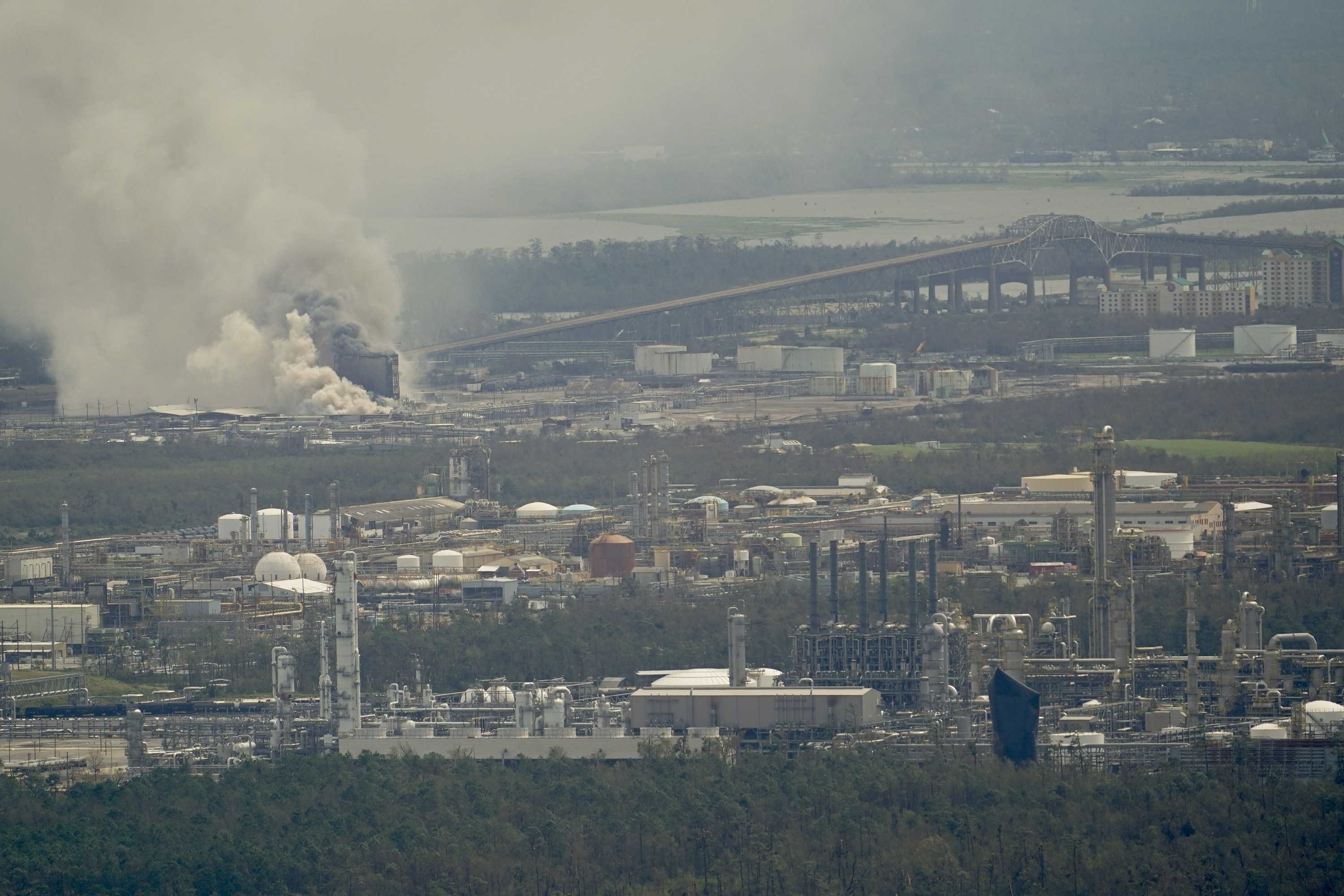
Two days after Hurricane Laura’s 150 mph winds finally subsided, Christine and Delma Bennett were back in Calcasieu Parish, Louisiana, to survey what was left of their home and the rental properties whose income the elderly couple depends on to pay their bills.
“It’s like somebody dropped a bomb,” Christine Bennett said. Along with her husband of 48 years and their children and grandchildren, she had fled to her son’s house in Texas in two cars stuffed with six people and as many of their things they could fit in. “Nearly every roof in the neighborhood is ruined.”
Worse than that, however, was what she feared the hours spent in the area had done to her health: Both she and her husband had headaches, which lingered for days. Bennett worried the couple had inhaled toxic substances, released from the area’s many petrochemical plants during the hurricane. “God knows what was in that air,” she said.
The Bennetts’ properties are in Mossville, a small unincorporated Black community on the outskirts of the city of Lake Charles. Originally founded in 1790 by formerly enslaved people, Mossville was a thriving community for over 15 decades until the 1950s, when the chemical industry began gobbling up nearby land. First residents welcomed the jobs, Bennett said, but slowly the expanding number of chemical plants crept closer and closer to people’s homes.
These days, just a few dozen families remain in Mossville. As they struggle to rebuild, they also find themselves at the leading edge of a problem that environmental experts fear may soon confront neighborhoods in numerous small towns and cities along Louisiana’s coast: the toxic aftermath of hurricanes’ howling winds and surging storm waters. What’s more: Given Louisiana’s lax environmental reporting requirements, the true extent of the environmental damage and long-term health impacts may never be accounted for. After all, environmental advocates note, they weren’t after Hurricane Katrina hit New Orleans or Hurricane Rita hit southwest Louisiana. Nor were the impacts of Hurricane Harvey in Houston in 2017 fully tallied — even though Texas’s environmental laws are stricter than Louisiana’s. Often, it is communities of color who bear the brunt of these problems because of racist zoning policies that funneled industry to Black and Latino communities.
“We just don't know what has been released since Laura because the system is designed to obfuscate,” said Anne Rolfes, director of the Louisiana Bucket Brigade, a nonprofit that works to give voice to the needs of communities located near industry.
When the Bennetts drove into Mossville on Friday, the area was under a shelter-in-place order because of toxic gas. A fire had ignited at the nearby BioLab chlorine plant, which processes chlorine for swimming pools.
“We haven't heard about any other leaks or spills, but they're not going to let that out,” said Christine Bennett. “With BioLab, that was just such a big fire that they couldn’t hide it.”

Greg Langley, press secretary for the Louisiana Department of Environmental Quality, said that the agency is confident that they will be able to address the environmental concerns that have arisen since Hurricane Laura.
“We're not naive,” Langley said. “We know there's bound to be some small amounts of spillage. We don't know how much, but it doesn't at this point seem to be any widespread large incidents.”
Leaks and spills have become part and parcel of hurricanes that hit Texas and Louisiana’s Gulf Coast. A Reuters analysis found that in the wake of Hurricane Harvey’s punishing rain in the Houston area, at least 22,000 barrels of oil, refined fuels, and chemicals were spilled across the state. That was in addition to millions of cubic feet of natural gas and hundreds of tons of other toxic substances. While Harvey had a widespread effect on Texas, the environmental damage paled in comparison to Hurricane Katrina. Researchers estimate that there were as many as 200 releases of hazardous chemicals, petroleum, or natural gas in the wake of that storm coming ashore south of New Orleans.
“These releases are a well-known problem,” said Nicholas Santella, a geochemist who studied the spills and leaks after Hurricane Katrina and now works at BSTI, an environmental consultancy based in Pennsylvania. “There has been some improvements in some aspects of planning, but in recent hurricanes, some of the same type of things, damage to storage tanks and other industrial infrastructure that results in really large releases, continue to occur.”
John Pardue, a professor of civil and environmental engineering at Louisiana State University, wrote in a piece for the Conversation about how the fire at BioLab may be just the tip of Hurricane Laura’s damage to the oil and petrochemical facilities. In that piece, Pardue points out that the storm’s strongest winds whipped through the Hackberry oil field, a marsh dotted with thousands of oil wells, storage tanks, and pipelines. Storage tanks have been known to be ripped from their moorings during hurricanes, releasing whatever toxins they had inside into the environment.

The Gulf Coast is home to a dense network of oil and gas refineries and pipelines and increasingly the booming petrochemical industry. And the industrialization is growing. Using state permitting data, the Environmental Integrity Project showed that between 2012 and 2018, regulators in Louisiana and Texas approved 74 oil, gas, and petrochemical projects within 70 miles of coastline. Many of the biggest projects coming online are in Calcasieu Parish, the county where Lake Charles and Mossville are located, and Cameron Parish, the county just south of Lake Charles that was almost entirely inundated by water during Hurricane Laura. But while regulators have been busy approving new projects in vulnerable areas, they have been unwilling to step up monitoring to protect the surrounding communities during disasters, activists said.
While Texas has made information about the pollutants released since Hurricane Laura available to the public, Louisiana residents are still largely in the dark. Few people think of Texas as a place that strictly regulates industry — except, maybe, in comparison to Louisiana. In Texas, companies must report big emissions events within 24 hours. They must also report how many pounds of pollutants they released. That’s how people learned that at least 4 million pounds of pollutants and greenhouse gases were released in the run-up to Hurricane Laura as plants in East Texas conducted emergency shutdowns ahead of the storm. Those plants emitted well above the allowed amounts of pollutants like nitrogen oxides, carbon dioxide, and volatile organic compounds in an effort to prevent accidents like when the Arkema chemical plant outside of Houston exploded and burst into flames during Hurricane Harvey. In Louisiana, Environmental advocates say they only know that more than 50 sites released pollutants in recent days. There hasn’t been a full public accounting of what was released or how many pounds of toxins were emitted; the state doesn’t require companies to report either data point.
The Biolab facility that caught fire, for example, did not report the amount of emissions emitted since Hurricane Laura hit. If that factory was in Texas that would have been required.
In Louisiana, plants are typically allowed up to a week to report any emissions event and even those rules were relaxed in March in response to the coronavirus. Ahead of the storm, the Louisiana Department of Environmental Quality issued an emergency declaration that further relaxed regulations extending reporting deadlines and loosening rules around completing repairs without preapproval. In a 2019 report, the Environmental Protection Agency’s inspector general chided state and local officials for failing to properly monitor air quality during Hurricane Harvey and then failing to effectively communicate the associated risks to residents.
Wilma Subra, an environmental scientist and chemist who has been working in Louisiana for decades, said she plans to spend the coming weeks collecting her own samples to try to piece together the effects of Hurricane Laura on the environment and health of southwest Louisiana. She said she will be looking for pollutants like hexachlorobenzene, hexachlorobutadiene, and mercury that she worries the storm surge may have washed into neighborhoods around Lake Charles area’s polluted waterways. The EPA says that hexachlorobenzene is a probable human carcinogen; studies suggest that hexachlorobutadiene causes damage to the kidneys and liver and may lead to kidney tumors; and mercury has been shown to affect the nervous system.
In 2019, BioLab, the plant that caught fire during Hurricane Laura, was found in violation of the Clean Water Act for releasing over 90 times the allowed amount of hexachlorobenzene into area waters. In all the facility has reported dumping chemicals into the nearby bayou and river 145 times since last September, according to data from the Environmental Protection Agency.
In a statement, BioLab’s parent company, KIK Custom Products, said it is actively engaged in helping the broader community recover from the impacts of Hurricane Laura.
BioLab is far from an anomaly. A new ethane plant in Westlake, a joint venture between Lotte Chemical of South Korea and Houston-based Westlake Chemical, has reported consistently releasing more than the allowed amount of the same chemical into area waterways since opening last year. According to EPA enforcement data, that plant is in significant noncompliance with the Clean Water Act. Not far away, the South African–owned chemical complex that led to the leveling of much of Mossville was dinged in 2017 for releasing nearly five times the allowed amount of mercury.
“With a storm surge, you have this sediment sludge that gets moved around,” Subra said. “After Katrina in the greater New Orleans area, some people didn't clean the sediment sludge from their property. And then they call me up after the grass has grown and they've fixed up their house and they say every time I mow the lawn I don’t feel well. That’s the sediment sludge that the lawnmower is throwing up into the air and they are inhaling it, so then we’re talking about long-term exposure.”

Subra hopes that if she can get to the problem areas early and get the information out there, southwest Louisiana can avoid that kind of issue this time around.
“If we get enough information out there, they'll be able to do something with that information, if we lack information, three to five years from now, they will look back and say, you know, I didn't have this health issue before and it started after the hurricane.”
Langley at the Louisiana Department of Environmental Quality said they were actively monitoring the situation in the affected areas and are working with parish officials to make sure they get what they need.
“We're still assessing to get a full picture of what has happened,” said Langley. “We know that we had a few small spills, we saw some sheen when our plane flew over. And we have a couple of planes still looking in wetlands for orphaned drums or any kinds of spills, sheens or industrial debris that's been blown around. We do have some areas of concern. There's a lot of oil and gas activity in that area.”
“We are trying to locate the companies’ people and identify responsible parties, and we will work with them to get cleanup people in,” he added.
Rolfes of the Louisiana Bucket Brigade said she isn’t optimistic.
“I can tell you right now, the clean up that Lake Charles needs won’t happen,” she said. “After Katrina, they just pressure-washed the sidewalks and the roads like that was going to solve the problem. I don’t expect much more this time.”
The Bennets, meanwhile, are focused on repairing their properties. They themselves moved out of Mossville in 2010. Christine Bennett said she and her husband held out as long as they could, but they were getting older and were terrified of the long-term health consequences of living next to the sprawling campuses of oil refineries and chemical companies. She hates living in Lake Charles, but she says her hometown just isn’t safe anymore. “There is always just this smell in the air,” she said.
